
Select Page
The APO has three flagship programs, which capture the essence of the organization’s wider work in promoting productivity enhancement and sustainable development in the Asia-Pacific: the Productivity Talks (P-Talks) series, Green Productivity (GP), and APO Accreditation.
P-Talks are a multimedia collection of digital content from leading experts and practitioners at the nexus of policy, work, and technology. The five different programs (P-Talks, Top-Talks, P-Innovators, P-Stories, and P-Insights) help showcase how countries and communities are driving sustainable productivity growth from paper to practice.
Green Productivity was launched in 1994 in line with the 1992 Earth Summit recommendations that both economic development and environmental protection would be key strategies for sustainable development. With the support from the government of Japan, the APO introduced GP as a practical way to answer the challenge of sustainable development.
The objective of the APO’s GP Program is to enhance productivity and simultaneously reduce the negative impacts on the environment. It seeks to realize this objective by propagating GP consciousness. The APO pledges to continue the progress in the Asia-Pacific Region and through cooperation extend GP to accelerate a growing green global marketplace.
The international multi-partied endeavors such as the landmark Paris Agreement in 2015 and the Glasgow Climate Pact, which was the outcome of the UN Climate Change Conference of Parties (COP 26) held in November 2021, aimed to limit the rise in global temperature to 1.5°C by focusing on mitigation, adaptation, financing, and collaboration. More than 150 countries that contribute over 90% of world GDP have made net-zero commitments and set new 2030 emission targets.
The APO recognizes this need to take urgent actions to mitigate climate change and hence, the APO’s Vision 2025 of Inclusive, Innovation-led productivity growth includes intensifying promotion and adoption of GP as a key strategic thrust. This includes enhancing the current programs on GP and expanding the scope of GP to take climate change into account. It directly supports the UN SDGs specifically SDG 6, 7, 13,14, and 15 through the activities envisaged.
Since the introduction of environmentally sustainable economic development at the 1972 Stockholm Conference on the Human Environment, environmental issues have evolved from being an intellectual pursuit of the few to a core business concern of the mainstream. With the closure of the 1992 Earth Summit in Rio de Janeiro, more than 178 governments adopted Agenda 21, the Rio Declaration on Environment and Development, and the Statement of Principles for the Sustainable Management of Forests. The time to move from rhetoric to results arrived. However, it is in the operational meaning of this defined phrase where much debate has ensued. The matter of ecological integrity, as well as social and economic equity, must become the focus of innovation. Just as human systems adopted agriculture and the use of fossil fuel as the first and second transitions that completely changed the way global society operated, the third transition that humans must address is to operationalize sustainability. To be successful, we must transform these three factors into meaningful policies, supported by unified social action, and show evidence of our success in our respective corporate triple bottom-line results. The APO believes that we have found a track that moves us from the evocative to where we have evidence of results. Here, we offer an introduction to Green Productivity (GP), its history, its methods, tools, and techniques.
GP is a strategy for simultaneously enhancing productivity and environmental performance for overall socioeconomic development. Its aim is well-rounded socioeconomic development that leads to sustained improvement in the quality of human life. It is the combined application of appropriate productivity and environmental management tools, techniques, and technologies that reduce the environmental impact of an organization’s activities, products, and services while enhancing profitability and competitive advantage.
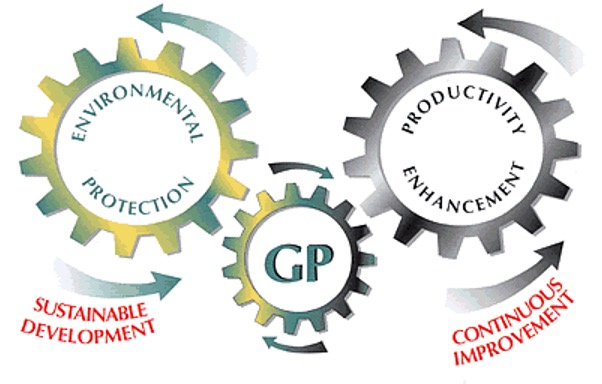
Innovation is a primary driver of economic growth. GP greens the process of innovation.
The starting line was productivity as a cost-reduction strategy. By picking up the baton of quality, productivity has metamorphosed to incorporate environmental protection and community enhancement as a means to increase prosperity. Under the umbrella of GP, innovation, a key engine of economic growth, becomes part of a holistic strategy to move toward a sustainable future.
Productivity is essentially a marathon without a finishing line.
Just as productivity was the essential strategy that enabled Japan to rebuild after the Second World War, with other Asian nations being attracted to the lure of its success, the 19 member economies of the APO have rallied behind a more broadly defined concept of productivity to race in the marathon for sustainability. In “The Concept of Productivity and the Aim of National Productivity Agencies” formulated in Rome in 1959, the Productivity Committee of the European Productivity Agency defined productivity as follows:
“Productivity is above all a state of mind. It is an attitude that seeks the continuous improvement of what exists. It is a conviction that one can do better today than yesterday and that tomorrow will be better than today. Furthermore it requires constant efforts to adapt economic activities to ever-changing conditions and the application of new theories and methods. It is a firm belief in the progress of humanity.”
GP starts with an intellectual dare: to shift from a monochrome bottom line to a more colorful triple bottom line.
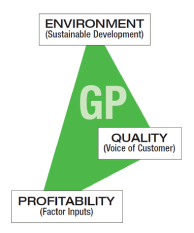
Previous approaches to environmental protection have tended to ignore economic performance. Regulators were tasked with the dubious honor of having to monitor closely those with the deepest pockets and most suspect of the greatest wrongdoing sparked by the events such as Chernobyl, Bhopal, and the Exxon Valdez. This surveillance has led to substantial reductions in single point-source pollution in most countries. However, it has left the seemingly trivial individual contributions of day-to-day inefficiencies in other larger and smaller enterprises and public organizations unattended.
Essentially, the practice of GP results in using material resources and energy more efficiently and sustainably, doing better with less. We know spurring innovation for products and services enhances economic development; therefore greening innovative minds enables development with less risk of socioeconomic and environmental degradation.
According to the World Economic Forum’s Year 2000 Report, the ability of a nation to improve its competitiveness is measured by its environmental performance in addition to more traditional economic criteria. Central to improved competitiveness is productivity. This makes the concept of GP a simple but elegant solution: make environmental protection a core business attractor instead of an isolated cost contributor.
The recognition that the environment and development are two sides of the same coin came in response to the need to link economic development strategies with environmental preservation. Between 1993 and 1994, a number of APO member economies were involved in research focused on applications and opportunities for cleaner production as the cornerstone for guiding Asian countries toward a more environmentally friendly industrialization. While the tools, techniques, and methods have expanded over the years, the goal has remained the same: balance environmental and economic needs. In doing so, we improve the quality of life for society as a whole. This balance is achieved by keeping a focus on quality (representing the voice of the customer), profitability (determined by how well you do with what you have, or factor inputs), and the environment (our natural capital).
In the current scenario of globalization, business volatility, and constraints related to the COVID-19 pandemic, the implementation of GP methodology can help enterprises improve their competitiveness and maintain profitability, leading to overall greener growth.
There is growing enthusiasm for the power of GP as a strategic driver for innovation. GP will help Asia-Pacific region and we hope others to innovate for a sustainable future.
GP starts as a strategy for enhancing productivity and environmental performance for overall socioeconomic development. It is the application of appropriate productivity and environmental management tools, techniques, and technologies to reduce the environmental impact of an organization’s activities, goods, and services. GP is a method by which any enterprise, large or small, can understand what it is they do or have that impacts the environment, reduces their efficiency, adds cost, and suppresses their productivity.
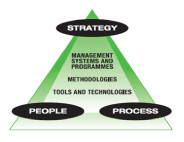
In its formal definition, GP uses three terms and phrases:
– strategy
– productivity and environmental performance
– socioeconomic development
Building on its strategic foundation, GP focuses on enhancing profitability through combined improvements in productivity and environmental performance. This engenders an important mind shift from the environment as a cost or externality to an asset and opportunity for increasing efficiency and profitability. The power of this mind shift is not to be underestimated. When excessive use of resources and materials or generation of pollution is seen as a manifestation of lower productivity as well as poor environmental performance, these are seen as manufacturing defects that need to be consistently corrected. The next level of GP offers the logical method drawn from quality management and provides practical tools and techniques. The knowledge and approaches under the umbrella of GP can help companies attack their productivity challenges with increased confidence, leading to a better bottom line and competitive advantage.
GP follows through on the strategic framework by seeking technical and managerial interventions, based on the concept of continual improvement. Asia’s strength in implementing and improving through the cyclical nature of quality management has been an asset in the initiation of GP.
Another important factor along with this mind shift is a transition from end-of-pipe thinking to design for the environment. Design changes necessitate R&D, and this evolves the response of a company from concentrating on the cost of clean-up to the excitement of innovating new products and services. This is a critical crossover, as innovation is a primary driver of economic growth. Making products and services greener as a condition of innovation is significant. It excites business, motivates investors, intrigues employees, and attracts consumers. Government has a role to play in fostering this crossover. Government policy is an important force to remove barriers to innovation and to think sensibly about supporting new technologies that enhance rather than degrade the environment.
GP is being aided by the shift to a demand-side market. As consumers have more money, they are asking for products with environmental sensitivity be it shade tree coffee, recycled paper stock, cars with lower emissions, or greener energy sources. The lucrative lure of the market is a carrot. As markets demand greener products and services, GP helps to push the supply side by providing a logical process and practical tools and techniques by which this transformation can be accomplished.
In six simple steps an enterprise can examine and evaluate both its production processes and products to reduce their environmental impacts and highlight ways to improve productivity and product quality. Implementation of these options leads to another cycle of review and so promotes continuous improvement.
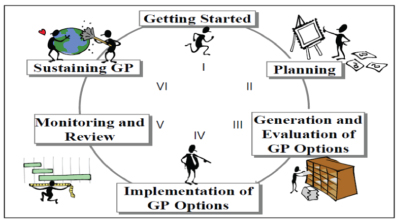
Getting started is an easy task. Identifying the people who are going to be involved and forming a GP team marks the beginning. These people, led by a champion, walk through and survey the site or facility and record first impressions. This allows the team to gather baseline data and identify areas where there may be a problem. This data-gathering activity is made even easier through the use of Eco-mapping, a simple, visual, practical tool for gathering, analyzing, and managing environmental performance, which is especially suited to smaller enterprises. It is vital to have senior management’s buy-in to ensure that adequate resources are available for successful implementation.
Planning allows an organization to utilize the information gained in the first step to analyze the potential for improvement, along with tools such as material balance, benchmarking, eco-mapping, and fishbone diagrams. Objectives and targets can be established and performance indicators identified to help guide the improvement process, allowing the company to manage and measure progress.
Generation and evaluation of GP options involve the development of options to meet the objectives and targets formulated in planning. They require a review of prevention of pollution and application of existing or new control procedures to support the development of options to enhance productivity. Options are screened against performance indicators. Those most likely to net the economic and technical results desired are given first priority; the company is now ready for action.
Implementation of GP options involves two actions, preparation and execution. Preparatory work includes awareness building, training, and the development of competencies. If new equipment and systems are required, these are installed along with the operator instruction and hands-on training to ensure success.
Monitoring and review of the new GP options are vital to see that they are producing or exceeding the anticipated results. This includes monitoring the whole system to ensure that it is on track and performing as designed. Findings are reported for review by management.
Sustaining GP requires action to correct where necessary or to build on existing success. Having a feedback loop is essential to keep progress on track and to respond to the changing circumstances imposed by internal and external drivers including customer expectations, the environment, and other innovations that may accelerate the greening of productivity.
Implementing GP methodology requires integrating and applying a number of key environmental management and productivity improvement tools and techniques. GP tools and techniques provide clues and directions for the generation of options and enable their systematic implementation. Different tools and techniques are used at different steps of the GP implementation process (see steps in the table below).
| Step | Task | Tool |
| Step I: Getting started |
|
|
| Step II: Planning |
|
|
| Step III: Generation and evaluation of GP options |
|
|
| Step IV: Implementation of GP options |
|
|
| Step V: Monitoring and review |
|
|
| Step VI: Sustaining GP |
|
GP techniques are used to bring about the changes that will result in better environmental performance and improved productivity. They range from simple housekeeping techniques to designing “green” products.
The GP Techniques can be categorized as under:
Waste Prevention
Preventive and Productive Maintenance
Resource Conservation
Product Improvement
Additional Information on Green Productivity
An accreditation and certification program was identified as one activity that could raise the APO’s visibility and authority as a leading productivity organization. Recognizing the competency and credibility of national productivity organizations (NPOs) or their affiliates as APO-accredited certification bodies (CBs) will build APO brand awareness, cultivate and expand a community of experts, and strengthen APO leadership in the area of productivity.
Therefore, the Governing Body, in its review of the APO Strategic Plans, approved the establishment of an accreditation body. This separate, impartial entity known as the APO Accreditation Body (APO-AB) is responsible for assessing and accrediting CBs following the APO General Requirements for Certification Bodies: Certification of Persons Scheme, which is aligned with ISO/IEC 17024.
To be the leading productivity-related specialist accreditation body and expand the recognition of APO certification programs worldwide.
To enhance the image and reputation of NPOs/affiliated organizations in APO members by recognizing them as APO-accredited CBs on productivity-oriented programs. This will involve:
The APO-AB is committed to operating its accreditation programs and related services at the highest quality in compliance with international standards to meet the needs and expectations of APO member governments. Through the balanced representation of key stakeholders and interested parties within or outside the APO membership, the APO-AB ensures that the professionalism, competency, impartiality, and transparency of its services are maintained at all times.


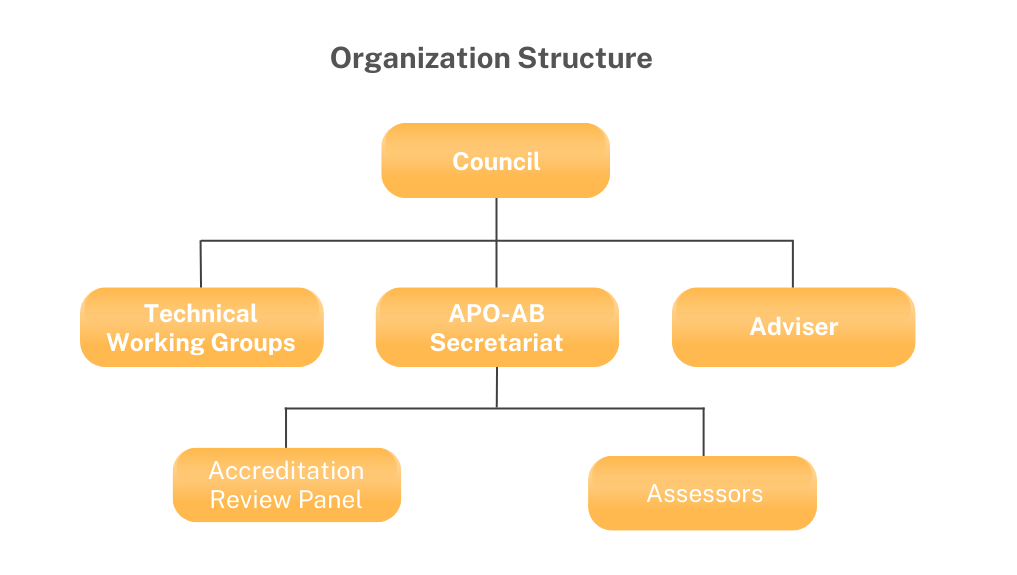
The main responsibility of the APO-AB Council is to formulate policies relating to the accreditation system for endorsement by the APO Workshop Meeting of Head of NPOs. The list of the members of the council is here.
The APO-AB accredits organizations that operate APO Certification of Persons (CoP) schemes. The APO-AB will develop new certification schemes periodically to meet the needs of member countries. Current schemes being developed are shown below:
| Program | Accreditation Requirement | Certification Scheme |
| Productivity Practitioners | • ISO/IEC 17024:2012 • APO-AB 1003:2020 General Requirements for Certification Bodies: Certification of Persons Scheme |
APO-PS 101: 2023 Requirements for Productivity Specialists |
| Green Productivity | APO-GPS 201:2023 Requirements for Green Productivity Specialists |
MALAYSIA PRODUCTIVITY CORPORATION CERTIFICATION BODY (MPC-CB)
Address: Lorong Produktiviti, Off Jalan Sultan, 46200 Petaling Jaya, Selangor, Malaysia
URL: https://www.mpc.gov.my/mpccb
Please click here for the certificate
VIETNAM PRODUCTIVITY SPECIALIST CERTIFICATION BODY (ViProCB)
Address: No. 8 Hoang Quoc Viet Road, Cau Giay District, Hanoi, Vietnam
URL: http://vnpi.vn/vn/chuyen-gia-nang-suat/productivity-certificate.aspx
Please click here for the certificate
MONGOLIAN PRODUCTIVITY ORGANIZATION CERTIFICATION BODY (MPOCB)
Address: Bayangol district, Peace avenue, 20 khoroo, 2nd floor, Erin International Building, PO-26-354, Ulaanbaatar 16081, Mongolia
URL: https://mpo-org.mn/mbtbb
Please click here for the certificate
PROFESSIONAL CERTIFICATION AGENCY FOR PRODUCTIVITY (PCAP)
Address: Vocational Building, 1st Floor, Jl. Jend. Gatot Subroto Kav. 44, South Jakarta 12710, Indonesia
URL: https://produktivitas.kemnaker.go.id/pcap-3
Please click here for the certificate
PRODUCTIVITY CERTIFICATION BODY OF PAKISTAN (PCBP)
Address: 11th Floor, Shaheed-e-Millat Secretariat, F-6/1, Islamabad, Pakistan
URL: https://portal.npo.gov.pk/productivity-certifications
Please click here for the certificate
NATIONAL PRODUCTIVITY COUNCIL CERTIFICATION BODY (NPC-CB)
Address: Rashtriya Utpadakta Parishad, 5-6 Institutional Area, Lodhi Road, New Delhi, India
URL: https://www.npcindia.gov.in/NPC/User/NPC-CB
Please click here for the certificate
ISLAMIC REPUBLIC OF IRAN PRODUCTIVITY CERTIFICATION BODY (IPCB)
Address : No. 16, Corner of Mir Emad St., Shahid Beheshti St., Tehran, I. R. Iran
URL: (under construction)
Please click here for the certificate
SINGAPORE NATIONAL PRODUCTIVITY ORGANIZATION CERTIFICATION BODY (SG NPO-CB)
Address: 11 Eunos Road 8 Lifelong Learning Institute #08-01, Singapore
URL: https://www.sgpc.sg/services/business-advisory-consultancy/nposg-cb-gps/
Please click here for the certificate
FTPI CENTER OF PROFESSIONAL CERTIFICATION (FTPI-PC)
Address: Thailand Productivity Institute 1025 Yakult Building 12, 14th Floor, Pahonyothin Rd., Phayathai, Phayathai 10400, Bangkok
URL: https://www.ftpi.or.th/en/center-of-professional-certification
Please click here for the certificate
Click here for the APO-Certified Productivity Practitioners